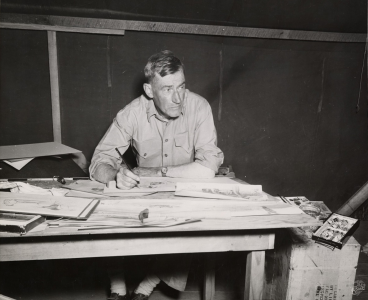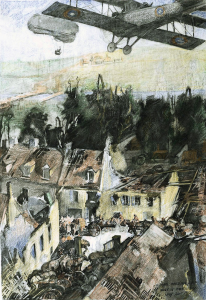

Biography
George Matthews Harding was born in Philadelphia, PA in 1882. His sister Charlotte was eight years his senior. She studied at the Philadelphia School of Design for Women and the Pennsylvania Academy of the Fine Arts (PAFA), becoming a successful illustrator during the "Golden Age" of American illustration. George graduated from the Manual Training School in Philadelphia in 1899, after which he briefly studied architecture at Boston Tech, the forerunner of the Massachusets Institute of Technology. At Charlotte's urging, George attended night classes at PAFA while working in the office of the architect Frederick Mann (1899-1900). Charlotte introduced George to Howard Pyle, the dean of American illustrators, and Pyle invited him to join his classes at Chadds Ford, PA in the summers of 1902 and 1903 and to study with him in Wilmington, DE.
Harding published his first illustrations in the Saturday Evening Post in 1903. And in 1904 he launched what would be a decade of global travels. He went first to Newfoundland where he lived for some months, sketching and painting. There he met the author Norman Duncan, with whom he took other trips and whose books he came to illustrate. In 1907 he was hired by Harper's Monthly Magazine as an author and illustrator. One remarkable trip that Harding took involved a seal hunting trip, where his ship was trapped and crushed by ice. This produced his article "When Our Ship Went Down," published in Harper's in 1909.
Harding's travels with Norman Duncan took him through the Middle East, Southwest Asia, Australia and China. He also took a voyage from the Caribbean northward to Newfoundland. And in 1912-1914 he embarked on a round-the-world trip. Returning to Philadelphia, Harding accepted a faculty position at the University of Pennsylvania, initially as an Assistant in Freehand Drawing. He was to remain at the University of Pennsylvania until 1935 as an Associate Professor in the Department of Fine Arts.
Harding's first mural was painted for the Traymore Hotel in Atlantic City, NJ in 1915. He continued to produce illustrated articles for major national publications, such as "Coaling Ports of the World," which he published in Harper's in 1916. That year he married Anita Cotheal Nisbett, with whom he had two children (Anita, b.1920 and George, Jr., b.1924).
When the United States entered World War I, Harding was selected as one of eight combat artists to join the American Expeditionary Force in France. The selection committee included friends of Harding's from PAFA, and his extensive travel experience was clearly a plus in the committee's eyes. This was a man who could paint anywhere (including on a sinking ship). True to his adventurous nature, Harding ventured close to the action and produced a large number of drawings and paintings. The selection committee had hope their artists would bolster the war's propaganda campaign and pushed the artists to produce more heroic footage. But Harding was more inclined to show the lot of the ordinary soldier and often disappointed them in that regard. General Pershing, on the other hand, was interested in artists who would create a historical record of the campaign and wholeheartedly approved of the artists' work.
After the war Harding returned to the University of Pennsylvania. He compiled his wartime artwork in a folio entitled "The American Expeditionary Forces in Action" and opened a studio in Wynnewood, PA He became a faculty member at PAFA from 1922-1958. He completed a mural for the Taylor Opera House in Trenton, NJ in 1921 and painted two murals for the Hotel Père Marquette in Joliet, IL in 1927. Harding had several mural commissions in the 1930s. Given his extensive experience, he won a major commission for the U.S. Custom House in Philadelphia, where his series of murals on the theme "Various Port Activities in Philadelphia" decorate the building's lobbies and rotunda. This work represents one of the masterpieces of Depression Era art.
Hardings also painted two murals for the Post Office Department in 1938: "Ben Franklin, Colonial Postmaster" and "Post Dispatch Rider." In 1939 he painted a mural for the North Philadelphia Station Post Office, "Mail Transportation and Delivery," and a large mural depicting man's mastery of machinery and natural resources for the Hall of Legislation at the New York World's Fair. He was named an associate member of the National Academy of Design in 1940. And in 1941 he painted the Kingston, PA Post Office mural "Anthracite Coal."
In 1942, Harding was 60 years old with a long and distinguished career behind him. But he was never one to turn down new challenges, so after Pearl Harbor he enlisted once more as a combat photographer, commissioned by the U.S. Marine Corps for campaigns in the Pacific. Harding was the only AEF artist to serve in both world wars. His work was shown in the 1943 show "Marines Under Fire" and the 1944 show "American Battle Painting 1776-1918."
Harding became a full Academician of National Academy of Design in 1945. And in 1952 he received yet another mural commission, this one for the Montgomery County Courthouse in Norristown, PA. His work there won a Gold Medal from the Architectural League. Harding painted murals of birds and other wildlife at the Audubon Shrine in Mill Grove, PA in 1954-1956.
PAFA held a Harding retrospective in 1957. Harding retired from PAFA in 1958 and was part of a three-man show (with Schilli Maier and Benton Spruance) at Lehigh University in 1959. He died in Wynnewood, PA in 1959.


Critical Analysis
George Harding is best known for two phases of his artistic work. The first and perhaps best-known phase is his role as a combat artist. Remarkably, Harding served in two world wars: first with the American Expeditionary Force in France in World War I, and later with the U.S. Marines in the Pacific Theater in World War II. Like any war correspondent, Harding could make quick impactful sketches, even on the edges of a firefight. He often used charcoal for these sketches, adding color in the form of a wash. While speed was an important factor in this work, Harding's focus was also important. He wanted to convey the feelings of ordinary soldiers in battle and added notes of humanity, not heroism, to most of his wartime work.
The second major component of Harding's work is found in the many murals that he painted. Although he first trained as an illustrator, his murals are always sophisticated compositions, never just blown-up cartoons. He would often use a triptych design or exploit natural divisions to portray simultaneously several different aspects of the subject at hand. His North Philadelphia Station murals, for example, are both triptyches, while his Kingston, PA mural shows workers in a mine elevator on the left, others gathered outside the mine in the center, and coal cars and a locomotive on the right.
There is a distinctive style in Harding's paintings, created by the way in which he layered his pigments. He would apply the paint in thin layers, with underlying layers showing through the upper layers. In this way he could create delicately variegated skies, seas, and clothing. This technique is evident even in paintings like those in U.S. Custom House in Philadelphia, where some areas of the work may have had thickly applied pigments but others show his characteristic layered technique.
Murals
- Washington, District of Columbia - William Jefferson Clinton Federal Building: Ben Franklin, Colonial Postmaster
- Washington, District of Columbia - William Jefferson Clinton Federal Building: Post Dispatch Rider
- Kingston, Pennsylvania - Post Office: Anthracite Coal
- Philadelphia, Pennsylvania - North Philadelphia Station Post Office: Mail Transportation and Delivery
- Philadelphia, Pennsylvania - U.S. Custom House: Various Port Activities in Philadelphia
References
- Captain George M. Harding (1882-1959) (Antique Illustration Art).
- George Harding (General Services Administration: Visiting Public Buildings).
- George Harding (Alchetron).
- George Harding (1882-1959) (Terenchin, Hudson NY).
- George M. Harding Papers (Pennsylvania Academy of Fine Arts).
- George Mathews Harding (ask ART).
- George Matthews Harding (Wikipedia).
- Max Kutner, This Riveting Art From the Front Lines of World War I Has Gone Largely Unseen for Decades, Smithsonian Magazine August 12 (2014).
- U.S. Custom House.National Register of Historic Places Nomination (2011).